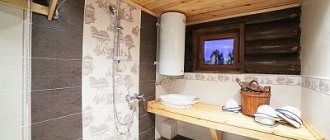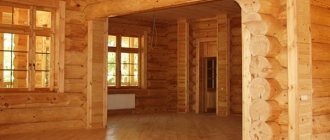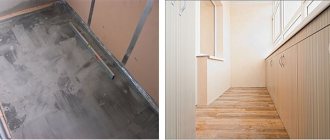Successful placement of door panels is the key to a good interior. They influence the ergonomics, functionality and overall perception of the room. To make the room comfortable, owners often decide to remodel. In this review, we will look in detail at how to move a doorway correctly and legally.
Punishment of violators Source infosmi.net
How to move a doorway in an interior partition
Often the standard layout and location of the door in the wall does not suit the owners.
Sometimes it prevents you from optimally arranging furniture or using space as efficiently as possible. Therefore, our company’s clients often ask how to move an opening in an interior partition and whether it is possible. Yes, this type of work is being actively carried out and there are no serious restrictions on this. With a professional approach, it doesn’t matter where or where the doorway will be moved. This could include filling a hole in the corner and installing a new one in the middle of the wall, or vice versa. Catalog of our products - we work in Moscow and the Moscow region
To move an interior door opening, you must first turn off the power to the room and remove the electrical wiring. Then they begin to make markings and draw the outline of the new door using a tape measure and a level. This outline is applied on both sides of the door. Having completed marking the doorway, cut out and knock out the intended part of the wall. Cut out the wall in small pieces. It would be a mistake to try to remove the entire opening. A sledgehammer is used for this process.
The part of the wall that needs to be removed can be quite heavy, so it is supported on both sides with wooden supports, which should be secured at the ends with iron corners.
After the final dismantling of the unnecessary opening, a new hole is cut out. If the wall is not very strong, it is advisable to fix the lintel . This is necessary in order to lighten the load on the door jamb. This load occurs due to the fact that the brickwork puts too much pressure on the door jamb. The absence of a lintel is fraught with excessive pressure on the masonry and even the collapse of part of the wall.
The materials for the lintel are a board with a thickness of 5 centimeters and metal corners. You can purchase a standard reinforced concrete lintel in the store. It is also called a pencil. Here you need to comply with certain requirements. The jumper should extend into the wall approximately 100 millimeters and must be flush with it. After this, several bricks are removed from the cut-down part of the wall and this part of the wall is prepared for installing the lintel. For proper fastening, you need to drill through holes with a hammer drill, and then use a hammer or sledgehammer to knock out areas of the required size that will be needed for the jumper.
To install the lintel, use a cement mortar. You can also use construction foam. To check whether the jumper is installed correctly horizontally, use a level. If the doorway has a non-standard shape and size (for example, the shape of an arch), then the lintel is made from U-shaped aluminum corners with the ability to screw them into the wall.
After strengthening the lintels, they continue to knock out that part of the wall where they plan to install a new hole for the door. The cleaned brick will be used to brick up the old opening. To remove old cement mortar from bricks, it is cleaned using a special building compound. You can also remove it from the brick with a hammer.
After dismantling the sawn part of the wall, a new door is attached, for which they install casings, level them and seal the cracks with construction foam. To fill an unnecessary hole in the wall, take a cleaned brick. To prepare cement mortar, sand and dry cement mixture are taken. They are mixed in a 4:1 ratio and filled with water. After this, you should get a homogeneous mass. For this type of work, it is permissible to use lime mortar with the addition of a dry cement mixture in a ratio of 4:1. The solution is also filled with water. This mixture is very reliable in operation, as it allows the bricks to be firmly glued together.
To seal an unnecessary hole, you will need some tools: a trowel, a hammer, a strong nylon rope and nails that are driven into both sides of the door hole to the height of one brick. After laying the first row, the nails are driven in at the level of the next row and the process is repeated again.
If the first row of masonry begins with a whole brick, then the second is laid with half. This masonry technology allows you to get a strong and reliable wall. You can also lay such a section of the wall with foam blocks. A nylon rope is needed to level the wall vertically. At the end of the process of laying the doorway, you should wait until the masonry dries. This usually takes no more than three days. You can mount a frame into an unnecessary hole and cover it with sheets of plasterboard.
Bringing beauty
Cleaning up after yourself after finishing the work is not enough. An old doorway, even one that has been carefully and smoothly sealed, must be plastered, painted, or appropriate wallpaper applied to it. In most cases, the matter is not limited to this place alone, so it is best to plan the relocation of the doorway during the renovation of the entire room or even apartment. And here you can turn on your imagination to the fullest.
Relocating a door in an apartment is not the most common renovation procedure, since it is considered a redevelopment. Incorrect placement of the interior door interferes with the efficient use of space in the apartment. Therefore, there is only one way out - to move the doorway by installing a new frame with the door.
Consumables and tools
Depending on the type of repair, the amount of material and type of tools will be determined. You can build an opening during the construction stage or make a cutout in an already finished wall.
During construction
The easiest way is to do it during the construction stage . There is no risk that the wiring will be affected or other communications embedded in the wall will be disrupted.
The materials you will need are brick - its quantity is determined based on the size of the wall: it is also important to decide how many bricks are being laid and go from there. The brick is used hollow or solid. You will also need M400 cement, sand and water.
Tools that will come in handy:
- trowel for laying mortar;
- cord and plumb line to create horizontal and vertical guides;
- pickaxe for splitting bricks in half;
- building level;
- order;
- square;
- roulette.
Types of brickwork
Textbooks on masonry work distinguish the following types of brickwork:
- chain;
- three-row;
- six-row;
- Gothic;
- double cross;
- special varieties used for facing masonry.
All of them characterize the suture dressing system. The densest masonry is chain.
It consists of an alternation of bonded and spooned rows with a quarter-brick bandage. It is mandatory when constructing load-bearing walls. Self-supporting structures can be made in six rows, and the cladding of the external walls is connected to the backfill using diaphragms or reinforcement. Installing door and window openings in brick walls during construction does not present any difficulties - concrete lintels are installed using a crane.
Reinforcement of load-bearing walls is included in the project, especially in multi-story buildings. Consider this before punching a new opening in a brick wall; It is possible that every four rows you will come across a steel mesh.
Working with reinforced concrete wall
Concrete walls are made load-bearing. Therefore, how to make an opening in such a reinforced concrete wall so as not to destroy the building is indicated in the regulatory documents. It is important to make the correct calculation of the reinforcing frame. It is better not to do such work yourself to avoid unpleasant consequences.
Such changes to the supporting structure require special permission. It is necessary to submit a work plan and drawings of the future redevelopment of the premises. Even the smallest nuances are taken into account in the documents. Only in this case can you count on approval of the work by the architectural organization. After receiving permission, you can begin work.
First, the future passage is marked. Moreover, it should be done on both sides of the wall. To ensure that the lines coincide, grooves are drilled in the corners of the wall and, starting from them, marking lines are drawn. Then holes are drilled around the perimeter of the opening, in increments of 30 mm.
For processing concrete walls, it is advisable to have diamond saws. They handle concrete surfaces easily. Without them, such work will take a lot of time and become labor-intensive.
The opening is framed in the broken wall. For this, a metal channel is used. You can install corners that are pre-welded to each other.
Channel reinforcement of the opening
Do I need permission to remove or move a non-load-bearing wall?
There are several types of work that must be formalized:
- partial removal of non-load-bearing fencing;
- creation of additional partitions. For example, arranging a study or dressing room;
- removing a partition to combine the living area and kitchen;
- transformation of load-bearing structures.
Redevelopment without approval is fraught with adverse consequences. Therefore, to legalize them, you should contact the administration or housing inspection staff. The application may be submitted through intermediaries - the government center
Expanding a doorway in a brick wall
The main thing that needs to be determined is in which wall the opening is expanding - load-bearing or non-load-bearing. If we imagine that the whole redevelopment consists of expanding the doorway in a brick non-load-bearing wall, then the way to coordinate this redevelopment is redevelopment in a simplified manner, that is, according to a sketch. For this redevelopment, it is not necessary to develop design documentation and it can be agreed upon post factum after completion. There are virtually no restrictions on the size of the expanded opening.
If the brick wall is load-bearing, then the coordination path becomes difficult. The fact is that when load-bearing walls are affected, it is necessary to develop design documentation from the author of the house project. And as a rule, 95 percent of these old houses and the original projects no longer exist. In this case, there is only one organization that replaces the authors of house projects - the State Budgetary Institution "Expert Center". And it is not always possible to expand the opening to the desired size; moreover, it is not always possible to expand it in principle. Therefore, each such case is considered individually on the basis of preliminary calculations in the technical report.
If you need the development of project documentation or its approval, then our company is always ready to help resolve this issue at an affordable price.
A few tips from experts will help you create a doorway in a brick wall:
- Sometimes when dismantling the masonry, some bricks begin to wobble. They need to be replaced with new elements, secured with mortar (to find out the correct proportions of mortar for laying bricks, read the article here).
- Disassembly should begin from the top in order to begin strengthening the opening earlier.
- It is recommended to choose a place for the future opening in the central part of the wall. This allows you to evenly distribute the load.
- Materials and tools must be prepared before the work process itself.
- Don't forget to leave a gap for the mounting foam. 5 mm will be enough.
- It is important to find out the presence of electrical wiring, fittings, pipes and other communications in the area chosen for the opening.
This video is about cutting out a doorway of non-standard sizes:
Some may think that it is not possible to cut a “passage” in a brick wall on their own. In reality, anyone can handle this kind of work, the main thing is to follow the correct sequence and not forget about observing safety precautions. Saving on materials is contraindicated, especially when it comes to load-bearing structures. Negligence will lead to disastrous consequences.
What kind of redevelopment does not require permission?
Some home improvements can be done without approval. These are works that do not affect the main structures of the house and are not associated with changes in the area of the premises.
7 works for which you do not need to obtain permits:
- glazing of loggias;
- wallpapering;
- installation of air conditioners;
- replacement of plumbing equipment;
- installation of a hood;
- laying laminate;
- replacement of linoleum.
There are other improvements that can be made without notifying the authorities. But owners often want drastic changes in order to create more comfortable living conditions. What is involved in refurbishment?
There are certain limits of permitted behavior for homeowners. You can do a limited list of actions to repair an apartment without permission. But if your imagination goes further, you will have to think about coordinating repairs.
5 main actions that constitute a change in layout:
- combining a bathroom;
- combining the loggia and the residential area;
- moving or eliminating walls;
- installation of a shower cabin;
- transfer of heating radiators.
Redevelopment can be legitimized after the fact, but this will be more difficult to do. It is possible that the housing inspection will not approve the transformation, and the owner will have to return the property to its previous form at his own expense.
Panel house
A pressing question for apartment owners is how to make an opening in the load-bearing wall of a standard panel house? In this case, it is assumed that part of the concrete slab that holds the upper tiers is cut out. In order to redirect the load from this area, steel jumpers should be used.
First you need to mark the wall according to the developed project. Then holes are drilled along these marks, indicating the base points. The main ones are the upper corner ones; focusing on them, you can remove part of the concrete and lay a lintel. If you are doing it in two parts, first you should install each half in the opening, extending a certain distance beyond its boundaries. Then drill holes for the screed with bolts, tighten them as tightly as possible and concrete.
You cannot continue working until the solution dries, as this may compromise the integrity of the structure.
After the concrete has hardened, you can proceed directly to cutting out the opening itself. Diamond cutters are used for these purposes. You need to work in stages:
- To begin, cut the general outline to a shallow depth on both sides, focusing on the drilled marks.
- Then divide the entire interior area into small sections.
- Saw the wall into these pieces and knock them out of the opening one by one.
The lintel is the main element in creating a doorway in a panel house
In order not to damage the floor, it is recommended to use a special elastic mat or improvised means, for example, car tires.
If you decide to create an arched vault, you need to use a bent channel to strengthen the opening. Additionally, strapping is installed on the sides. In this case, all elements of the supports must follow the contours of the future opening.
What changes will have to be abandoned?
What redevelopment is permitted is determined by law. Do's and don'ts must be followed by apartment owners. After all, a repair team can carry out almost any project for money. But whether such actions will be legal is another question.
3 prohibited techniques for changing the layout:
- placing a bathroom above the living rooms;
- connecting floor heating to general heating systems;
- connection between the room and the kitchen with a gas stove.
If the common property is annexed, then such actions are contrary to the law. Apartment owners have the same rights to the property of an apartment building.
Actions that threaten the integrity of the building and the normal operation of engineering structures are prohibited.
The process of laying an opening
When working with a load-bearing wall, the situation becomes somewhat more complicated - the masonry must be carried out quite quickly and with increased requirements for strength and reliability. In this case, only specialists always work, because mistakes can lead to safety violations (work done incorrectly can lead to the entire wall collapsing, which is especially dangerous in a multi-level residential building).
Why us?
Our company has a lot of advantages over competitors:
1. The craftsmen have been working in this field for a long time, so they have accumulated considerable experience, allowing them to quickly and efficiently carry out all the work; 2. We provide multi-stage quality control of the work and can guarantee that the laid opening will be invisible and will last no less than the life of the house itself; 3. Specialists will provide full consultation, both regarding the work being carried out and on the selection of suitable materials.
Consequences of unauthorized reorganization
Some citizens improve at their own discretion and live this way for years, but sometimes it happens that the deception is revealed. For example, when selling a home. It happens that a shower stall is installed, and no one will know about it. But if the neighbors are suddenly flooded, then information about the reconstruction may well become known to government agencies.
Important! The violator will have to pay a fine of up to 2.5 thousand rubles. and try to legitimize their actions after the fact. If the attempts are unsuccessful, the housing will have to be returned to its original form.
Question details
Variations of openings and finishing options
The opening can be made in both a brick and a panel house - it does not matter significantly. It must necessarily fit into the overall interior of the room. First of all, you should choose the option that you need, and only after that you can start working. Next, let's look at what people are doing and, perhaps, you will choose the appropriate option for yourself if you have not yet decided on it. For example, a doorway can be finished with additional trim, or artificial stone can be used.
Factors for ensuring the safety of redevelopment
Any type of construction work that is associated with the supporting structure of the building must be correctly and accurately calculated. The fact is that the walls of buildings are capable of experiencing colossal loads, and for this reason, the design of the opening should be approached thoroughly. If you make a poor-quality redevelopment, as well as disrupt the technology of the house, this can lead to the fact that the house partially or even completely collapses.
When calculating, you should take into account a number of important factors that will influence the final result:
- Types of materials used to construct the building.
- The technical condition of the building, in particular the floors.
- Thickness of wall load-bearing structures.
- Load on the area with the structure where you plan to make the opening.
- Internal layout of the room.
- The dimensions of the planned opening, as well as how well it will correspond to the dimensions of the walls.
When the project has been calculated and all factors have been taken into account, it must be approved by the supervisory service. Work on moving doorways can begin only after the project has been approved.
Types of openings
Making an opening in the load-bearing wall of a panel/brick house is not so easy. The complexity of the calculations for designing the transfer of a doorway in load-bearing walls will depend on the configuration of the planned opening.
The complexity of the construction work, as well as the order in which it is carried out, will directly depend on which option you choose:
- A standard straight type opening - it is cut into the partition from scratch. In the calculation, it is necessary to take into account the existing doorway, which will take part of the load from the supporting structure. According to the design documentation, this opening should be left untouched or it can be filled with bricks.
- An opening made in the form of an arch is much more difficult to make, and during the calculation you will need to take into account the bending trajectory. Calculations for an arched opening in brickwork will be particularly difficult, because the placement of masonry joints will need to be taken into account.
- Partial transfer of the passage - here it is assumed that the lintel of an existing passage is shifted in the direction you require. You need to cut a new passage fragment of the size you need. The unnecessary part of the opening should be filled with bricks.
Responsibility under the law
Law
Russian legislation has far-sightedly provided for the actions of some self-confident tenants who decided to ignore all of the above and move the doorway in the apartment on their own. Administrative punishment for such actions will follow sooner or later. This can be a fairly significant fine, calculated in a tidy sum, which is beyond the means of the majority of the population of our country. Or an order to return everything to its original state, and at your own expense, which will also cause a significant loss to the family budget. It is worth noting that if the redevelopment was carried out by previous residents, and for some reason this was not discovered earlier, then those who currently live in the apartment will have to eliminate all changes that do not comply with the law. So when buying an apartment, you need to pay attention to this and obtain the necessary documents in order to avoid troubles later.
Technology for punching doorways in different types of walls
There is a plinth at the bottom of the wall. If it does not come off after a couple of blows with a hammer, then there is no need to touch it: it is laid on a concrete screed and secured in it. This plinth will move away from the wall on its own after the bricks are destroyed.
Next, you need to try to make an approximate calculation of the thickness of the wall, analyzing the type of masonry. Regardless of the result obtained, the dismantling of bricks begins from the middle part of the future opening. That is, from the middle of the marking.
The construction of an opening in walls of any type and any thickness begins with punching the middle in the shape of the letter “T”, the horizontal part of which must correspond to the upper marking line and extend 10-15 cm beyond its vertical edges. These gaps will allow a beam to be placed in them to support the masonry.
For load-bearing walls, this should be a strong concrete or wooden sheet of such thickness that it fits almost flush into the horizontal part of the T-shaped space. For non-load-bearing and semi-load-bearing walls, an ordinary board will be sufficient.
- remove or knock out bricks, moving towards the vertical marking lines;
- a disc with a diameter of 200-250 mm coated with diamond is installed on a powerful grinder;
- Using this tool we make the top and side cuts of the opening even.
Step-by-step instructions for making a jumper
In order for everything to really work out correctly, the jumper must be made with maximum compliance with the assigned tasks. The developed step-by-step instructions can help with this. You just need to be careful and not skip technological steps:
- First you need to prepare the channels of the required size. For example, if we are talking about an opening of 2.5 m, it is better to take a three-meter steel channel No. 18.
- Then you will need to make holes in the channels for the tightening bolts (the recommended fastener diameter is 20 mm, and the length should be such that it allows them to protrude 50 mm from each side of the wall.
- Next, on the load-bearing wall that goes under the opening, you will need to mark the opening itself, as well as indicate the placement of the steel lintel.
- Then you need to drill through holes to indicate the location of the opening and lintel on the other side of the wall too.
- Then you will need to remove the plaster from the designated areas.
- Using a jackhammer or manually, you need to prepare niches (they are also called grooves) on both sides of the wall - for the subsequent installation of channels. The depth of the gouging should be about 10 cm, and the height - about 18.
- Next you need to prepare (drill) holes for the coupling bolts according to the markings.
- The seats for the channels must be cleaned most thoroughly. And then moisturize.
- Next, cement mortar is applied (cement grade M100, at a minimum, and preferably more).
- And using the pressing method, the channels are “set” - each in its place.
- Next, you will need to insert the mounting bolts through the corresponding holes and tighten them.
- Then each channel must be filled with brick or cellular concrete.











